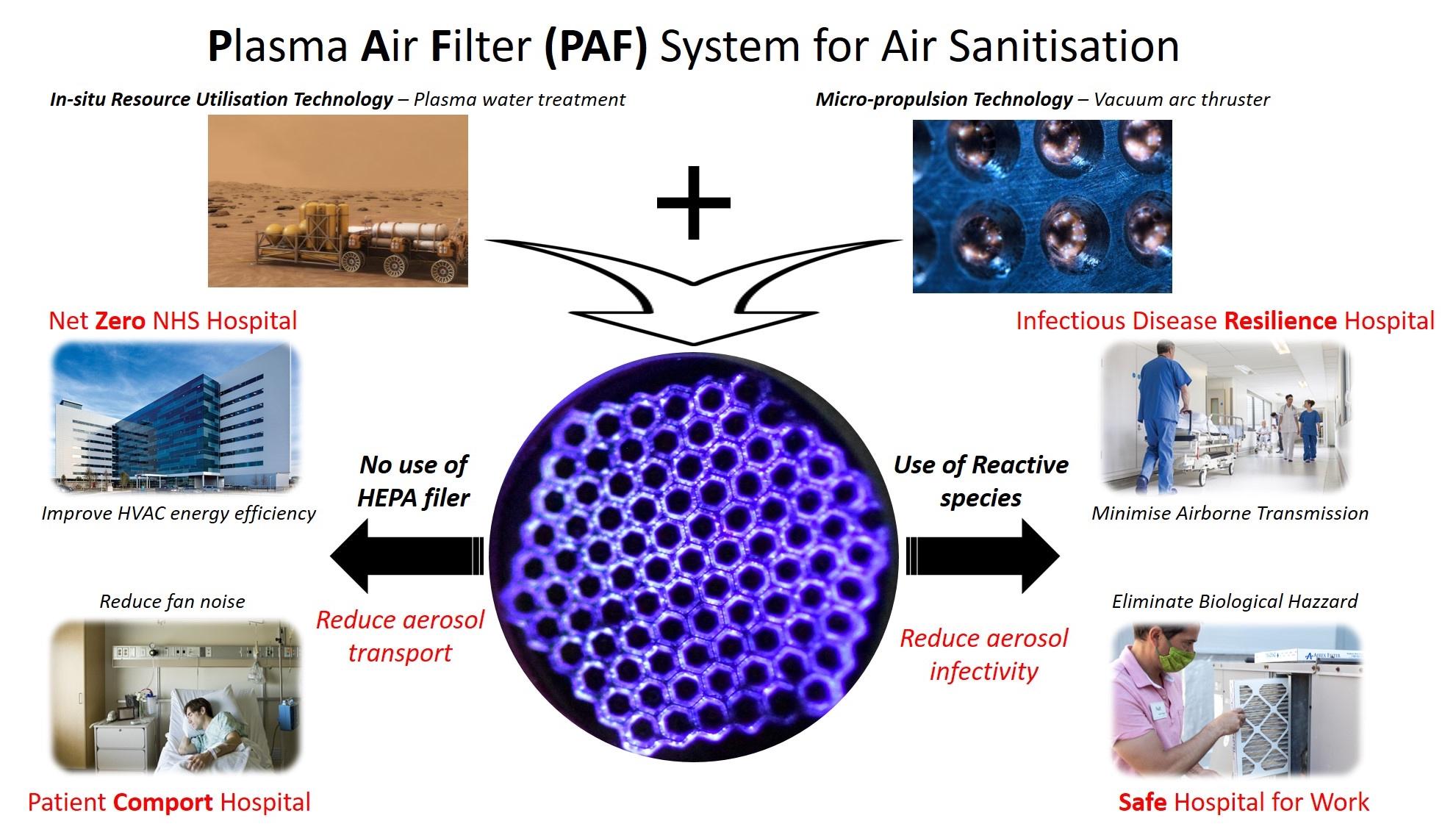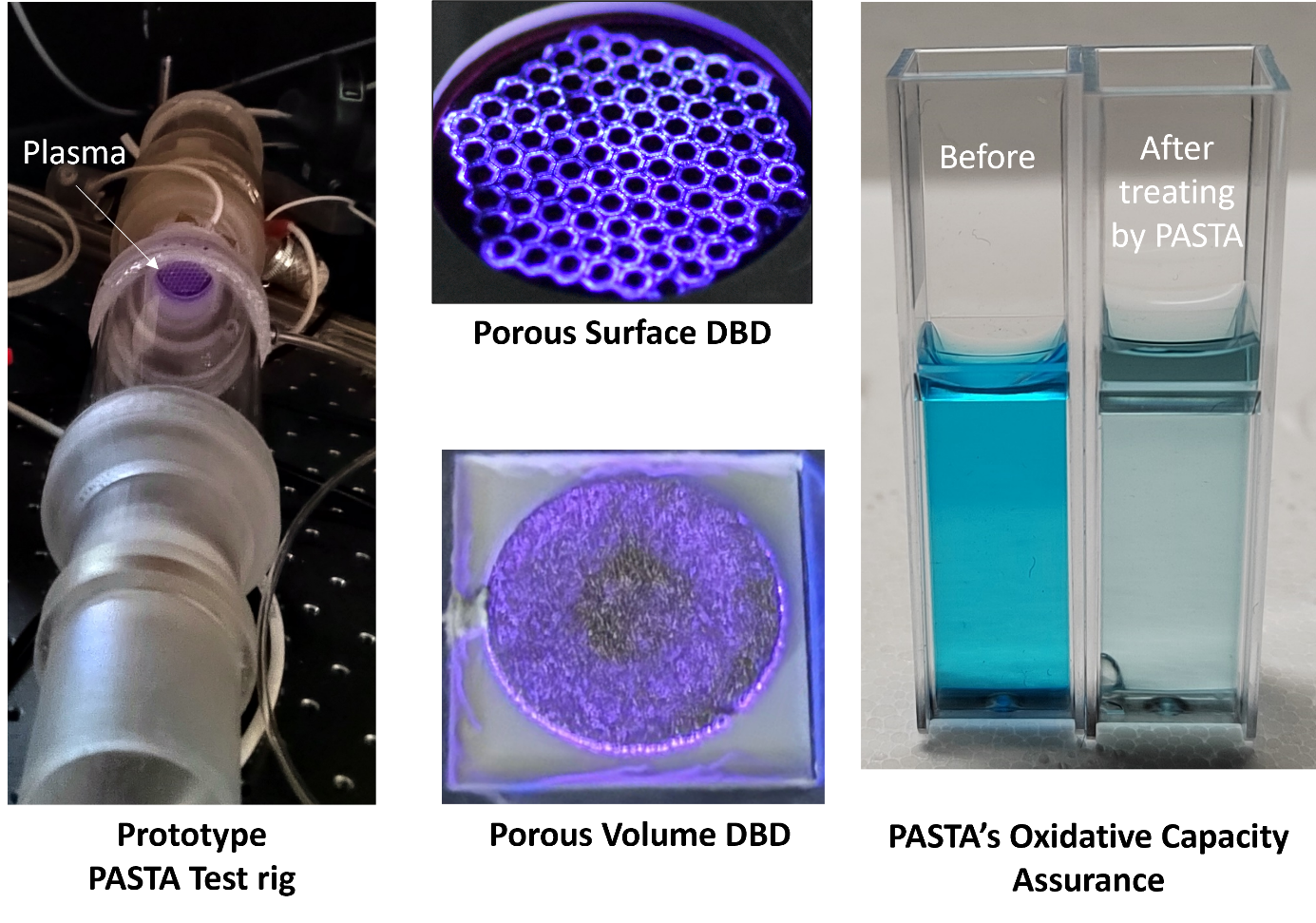
Objectives of the service
PASTA’s main objective is to use the viricidal and bactericidal capability of nonthermal plasmas to decontaminate and sanitise air without using filters or UVC. The goal of the PASTA project is evidence the potentials of the concept of a plasma-based air decontamination solution and quantify its decontamination capability against airborne pathogens.
Such a solution is designed to meet satisfy the requirements from NHS Hampshire hospitals and validate the prototype system performance under the operating conditions of NHS Hampshire hospitals.
Users and their needs
More than 900,000 patients a year in England are infected while receiving medical treatment in hospitals. Recent studies demonstrate that airborne transmission is responsible for more than one third of hospital-acquired infections. It means approx. 300,000 patients a year acquire airborne infection in NHS hospitals. The COVID-19 risk study [Nguyen et al] highlights that people who work in hospital settings had higher COVID-19 infection rate (20.2%) compared with that of the general population (14.4%). The direct user/beneficiary of the proposing system, is the University Hospital Southampton NHS Foundation Trust as an early adopter, in which the proposed system can be installed in areas less able to guarantee airflow rates and in waiting rooms. Building HVAC engineer and air filter suppliers, including Hamilton HVAC and Air Filtration Solutions, are targeted customers in the supply chain. The benefit of the proposing system can also be extended to broader environments requiring safe clean air:
- Dentistry and Operating theatres where appropriate in poorly ventilated dental surgeries/treatment rooms, but not likely to be beneficial in spaces with high ventilation rates.
- Negative pressure rooms and areas including bronchoscopy rooms, sputum induction rooms, emergency room waiting area, airborne infection isolation rooms, and radiology waiting rooms
- Private labs, buildings, and confined spaces such as cruise ship and public transportations where air quality can be quickly compromised.
Service/ system concept
The concept of the proposed system uses the viricidal and bactericidal capability of non-thermal plasmas to decontaminate and sanitise air without using filters or UVC. It is designed as a portable platform so that the system can be easily deployed within the hospitals including poorly ventilated areas, clinical areas and waiting areas.
Preliminary biological test results show that it is possible to achieve higher than 4-log reduction (99.99%) in pathogens without using filters and fans, and that chemical compounds decompose. Therefore, the system can be applied to inactivating viral particles and reducing VOCs; eliminating the risk of the infection caused by viral/bacterial residues on filters; reducing the noise and discomfort caused by noisy fans.

Space Added Value
The PASTA makes use of the outcomes of plasma generation technologies developed through contracts for space applications:
-
Space propulsion technology
Through ESA TDE (Cube-de-ALPS, 4000132060/20/NL/RA), a compact high-voltage pulse generator was developed as the power processing unit (PPU) of Cube-de-ALPS. This PPU was originally used as an ignitor of a vacuum arc thruster in the Cube-de-ALPS system.
-
Planetary protection and Life-supporting system technology
Through the UK Space Agency Exploration programme (UKSAG22_0006), a porous plasma reactor through which air can pass was developed. The porous plasma reactor can generate plasma-activated air and inject it rapidly into a water sample through a membrane system. Reactive oxygen species (ROS) in the plasma-activated air were used to inactive pathogens and decompose chemicals. It was demonstrated that the system can inactivate 100% of E.coli K-12 and decompose 95% of chemical compounds in water samples.
Current Status
The starting point for the project is that low-temperature plasma generated using an in-situ water treatment system has bactericidal and virucidal capabilities against pseudomonas aeruginosa, enterococcus, and SARS-CoV2. Preliminary biological test results that show 4-log reduction (99.99%) can be achieved by plasma treatment. Currently, a portable porous plasma generator that allows air to pass through it with minimum pressure drop is developed. Although the current plasma generator is powered by AC, the project team is testing the feasibility of using a plasma thruster power processing unit for the generation of low-temperature plasma to improve the power efficiency.
The feasibility of using plasma to sanitising air by measuring oxidation capability of plasma activated air is explored. The results of a preliminary study is showing its oxidative capability. In the study, the team injected plasma treated air into water to quantify its oxidation capability. Methylene Blue (MB) was used as an indicator of oxidation level. After 5 min treatment, 95% of MB has been decomposed by plasma treated air, which is demonstrating strong oxidation capability of plasma treated air. In addition, the team currently plans to perform a new biological test against SARS-CoV2 to measure actual air decontamination efficiency of plasma.

The PASTA test rig has been designed and assembled to validate and verify its performance. It comprises three main sections: pathogen injection and collection, plasma reactor, and post-treatment sections. The pathogen injection and collection section seed airborne pathogens and collect plasma-sterilized air samples to assess sterilization efficiency. The plasma reactor section, the core of PASTA, generates plasma to sterilise air using reactive species. Two types of plasma reactors are employed: porous surface DBD and porous volume DBD reactors. While the porous surface DBD utilises state-of-the-art printed electronics to generate intensive plasma, its lifetime is limited. In contrast, the porous volume DBD reactor has weaker plasma intensity but a longer system lifetime, making it the primary plasma generation method for PASTA. Additionally, a porous surface DBD reactor is included for boosting mode, enhancing sterilisation quality in critical areas such as surgical theatres and intensive care units. The implemented post-treatment section of PASTA ensures the safety of plasma-sterilized air by removing its byproduct, ozone.



